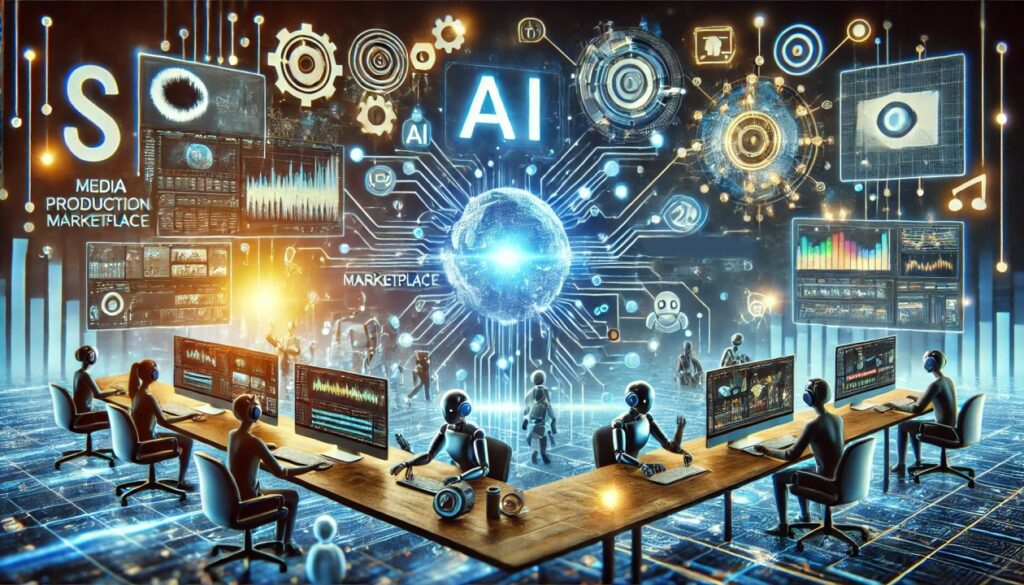
When we look into modern trends in B2B marketing, media production workflows are undergoing a revolutionary shift, thanks to advancements in artificial intelligence (AI) and the rise of marketplace partnerships. The integration of AI-driven tools and third-party service platforms is reshaping how businesses create, manage, and deliver content at scale. This transformation is not only increasing efficiency but also improving creativity and collaboration, making it an essential trend for B2B organizations aiming to stand out in competitive markets.
The State of Media Production Workflows in B2B Marketing
Media production workflows in B2B marketing traditionally involve several interconnected stages: pre-production (planning), production (filming/recording), post-production (editing and review), and delivery (distribution and feedback). Despite the structured nature of these workflows, many organizations face common bottlenecks, such as inefficient collaboration, file management issues, and prolonged review cycles.
According to a recent report by HubSpot, 61% of marketers cite content production as their biggest time investment, with 29% noting that internal inefficiencies in production workflows delay their campaigns. In B2B, where timely delivery of high-quality media assets can define the success of thought leadership initiatives, product launches, and webinars, these challenges can hinder growth.
Enter AI and marketplace partnerships—key innovations that are redefining workflows by automating repetitive tasks, improving resource allocation, and enabling collaboration on a global scale.
How AI is Transforming Media Production Workflows
Automation of Repetitive Tasks
One of AI’s most significant contributions to media production workflows is the automation of repetitive and time-consuming tasks. Tools such as Adobe Premiere Pro’s AI-powered features and Frame.io’s auto-syncing capabilities allow editors to streamline file transfers, organize assets, and even create rough cuts based on predefined rules.
- Transcription and Subtitling: AI tools like Descript and Otter.ai automatically transcribe audio and video content with remarkable accuracy, enabling faster turnaround times for internal reviews and external content distribution.
- Color Grading and Scene Detection: AI tools are also capable of automatically color-correcting footage and identifying key scenes in hours rather than days, reducing post-production timelines significantly.
- Impact: According to a study by McKinsey, companies that have implemented AI in their workflows have reported a 20-30% reduction in time spent on media post-production tasks, allowing creative teams to focus on higher-value activities.
Smarter Resource Allocation
AI enables more intelligent resource allocation by analyzing past projects to predict timelines and workloads. For example, tools like Wrike and Monday.com use machine learning to identify potential bottlenecks and optimize task assignments based on team availability.
- B2B marketers producing case study videos or large-scale webinars can now predict staffing needs and ensure their teams are not overburdened during critical production phases.
- Predictive AI helps ensure that review cycles are streamlined by automatically notifying stakeholders at the right moments, reducing the need for back-and-forth coordination.
Marketplace Partnerships: The Next Step in Collaboration
Alongside AI tools, partnerships with marketplace platforms have become a key element in modern media production workflows. Marketplaces like Upwork, Fiverr, and Toptal provide businesses with access to a global pool of specialized talent for editing, design, and motion graphics, making it easier to scale up during periods of increased demand.
Benefits of Marketplace Partnerships:
- Access to Specialized Talent: Instead of hiring full-time team members for short-term projects, B2B marketers can engage freelance professionals through these marketplaces to fill skill gaps.
- Cost-Effectiveness: A 2023 survey by Deloitte revealed that companies using flexible workforce solutions reported a 30% lower cost per project compared to organizations relying solely on internal teams.
- Faster Turnaround Times: By outsourcing editing, design, or motion graphics, businesses can shorten project lifecycles without compromising quality.
For example, a B2B tech company creating an explainer video for a product launch may use a marketplace to hire a motion graphics expert for a one-time need, allowing the internal team to focus on storytelling and content strategy.
The Synergy Between AI and Marketplace Partnerships
The combination of AI tools and marketplace partnerships creates an optimized workflow that leverages both automation and human expertise. Here’s how this synergy impacts B2B marketing:
- Hybrid Collaboration Models: AI-driven platforms can be integrated with freelance management tools, allowing seamless collaboration between in-house teams and external contractors. For example, project managers can use platforms like Frame.io to share AI-generated first cuts with remote video editors, ensuring consistent feedback loops.
- Enhanced Personalization at Scale: AI tools can analyze audience preferences and engagement data to inform creative briefs shared with marketplace collaborators. This ensures that media assets are tailored to target audiences, even when outsourced.
- Faster Iterations and Campaign Launches: AI streamlines internal processes, while marketplaces provide additional capacity, enabling faster iterations of webinars, promotional videos, and branded content for product launches.
Trends Shaping the Future of Media Production Workflows
- Cloud-Based Collaboration: The shift to cloud-based platforms has made remote collaboration more efficient. Tools like Adobe Creative Cloud, Dropbox, and WeTransfer integrate AI to enhance syncing and media file version control.
- AI-Powered Review Tools: AI review tools like Wipster and Frame.io can automatically detect issues such as audio inconsistencies or missing captions, alerting stakeholders during the review process.
- Decentralized Production Teams: B2B organizations are increasingly adopting decentralized teams that rely on marketplace talent and AI for specific project needs, resulting in more agile workflows.
Media production workflows in B2B marketing are evolving rapidly, driven by the convergence of AI technology and marketplace partnerships. This combination enables businesses to produce high-quality media content more efficiently, meeting the growing demand for video, webinars, and digital assets in their marketing strategies. By leveraging AI’s automation capabilities and accessing global talent pools through marketplaces, B2B organizations can overcome production bottlenecks, reduce costs, and deliver content that resonates with their target audiences.
As the demand for fast, scalable media production continues to rise, businesses that adopt these innovations will be better positioned to adapt to industry trends and maintain a competitive edge in the evolving B2B landscape.
